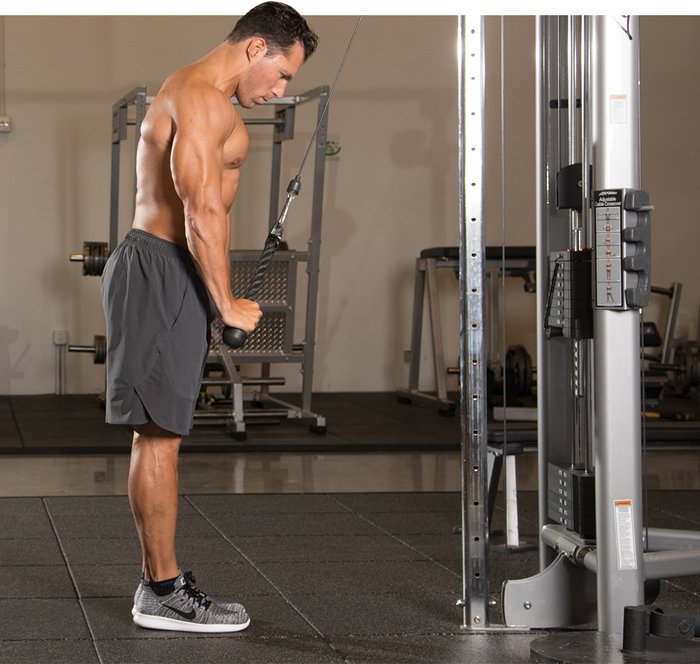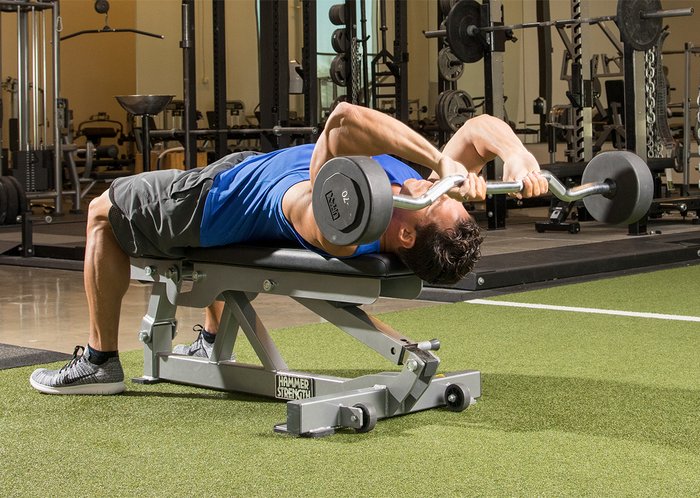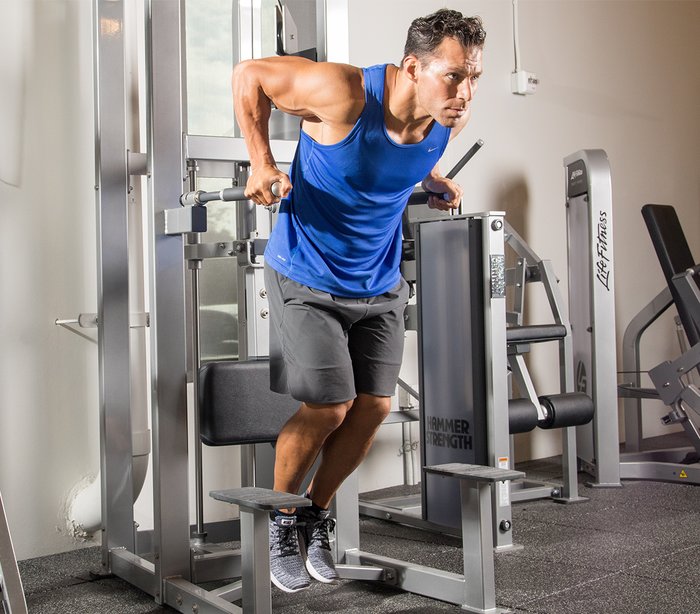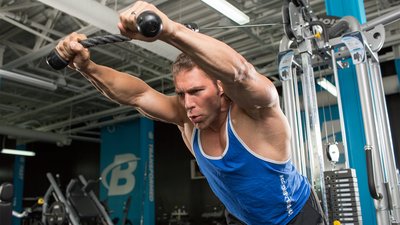If you've been working on muscle growth for a while, you know it's harder to add muscle the longer you've been hanging around a weight room. So if consistency and repetition aren't enough, what can give you that added boost? Tricks and tips, baby, tips and tricks.
I've teamed up with Cellucor-sponsored IFBB physique pro Craig Capurso to give you the scoop on a half-dozen insider tips for advanced arm gains. These are sleeve-busting techniques that will obliterate training plateaus and re-ignite muscle growth.
But they aren't for beginners. We go way beyond the basics to give you gym veterans out there solid advice to get your triceps growth back on track. Here's a rundown of the top six.
1. Don't Start With Press-downs!
The first exercise in any body-part routine should be the most challenging, the one you do with the most weight. So unless you're warming up your elbows, don't start your triceps workout with cable press-downs!
All of the press-downs (overhand, underhand, rope, V-bar) are single-joint exercises that lack the anabolic kick of multijoint exercises. Don't start your workout with an exercise that's light on muscle-growth stimulus or one that can prefatigue your arms before you ever get to your bigger multijoint movements. Sure, start off your workout with a single-joint exercise every now and then, just to mix it up. But it should be the exception, not the rule.

"In most cases, I'm going for broke when I begin a training session, because that's when I have the most energy," says Capurso. "Smash the big lifts early, and you'll get some real work in. So instead of press-downs, start off with multijoint exercises like close-grip benches, weighted bench dips, the triceps-dip machine, and weighted parallel-bar dips for triceps."
Capurso also recommends front-loading your workout with very heavy weights and as few as six reps per set instead of the usual eight or more.
2. Take It Overhead
One great trick for arm growth is to reach for the skies. The big, beefy triceps long head attaches on your scapula (or shoulder blade), and is fully stretched only when your arms are in the overhead position.
For a muscle to contract forcefully, it must be fully stretched first, and that won't happen if your elbows are stuck by your sides. (In that position, the lateral head takes on a greater portion of the workload.) To develop your long head, make sure your routine includes overhead barbell, dumbbell, or cable extensions.
"A good way to better isolate the long head is to use a low-back chair for support," says Capurso. "When you do overheads—or really, any exercise—standing up, your core does a lot of the work. By supporting your back, you can focus all your energy on isolating the triceps."
To maintain balanced upper-arm growth, include at least one arms-overhead movement in your routine. For a real change of pace, try doing an entire workout using long-head-focused exercises only.

3. Stop Training Like a Zombie
There are lots of triceps exercises. Dozens. So why is it that people tend to rely on just a handful of go-to exercises for this or any other body part?
Maybe it's because these exercises are easy to set up, or maybe you just go into zombie mode when you step into the gym. Either way, don't forget the law of diminishing returns: The more you do an exercise, the less benefit you gain from it.
A 2014 study published in the Journal of Strength and Conditioning Research found that changing exercises is more important to improving muscular strength than varying loading schemes.[1] Doing what you've always done isn't a growth strategy; it's a formula for stagnation.
4. Play With Your Angles
In lifting, as in billiards and baseball, it's all in the angles. Just as you can increase the efficiency of your chest workouts by switching between incline, decline, and flat-bench presses, you can nail on those Clydesdale-size horseshoes by changing up your grip and arm position.

Don't stop there. Close-grip bench presses don't always have to be done on flat benches. By adding incline and decline versions of the press, you're slightly altering the muscle-recruitment pattern and point of maximum stimulation. The same is true of skullcrushers.
But wait, there's more! Exchange an EZ-bar for dumbbells and you get a totally different feel, especially if you turn your palms so they're neutral, called a hammer grip. And to get really wild and crazy, use a cable attachment, so the line of pull is coming from an angle rather than a straight-down pull of gravity.
Mix and match these variations for still more new stimuli. The whole idea is to keep stimulating new muscle growth and avoid training plateaus by continually changing the exercises you do and the way you do them.
5. Go Extreme
So, yes, varying your exercises is a smart way to invigorate your training. But it's not the only way. If you've fallen into the 3-sets-of-10-reps trap, you've got a whole other way to add variety to your workout.
"I like to bring all kinds of funk to my routine, not only to stimulate new muscle gains, but also to keep the workout itself mentally refreshing," says Capurso. "I don't feel like I've worked unless I do something that starves the target muscle of oxygen."
Funk up your training and add greater muscle stimulus by trading 3-sets-of-10 for some 5-by-5s or another variation beyond the traditional boundaries of bodybuilding training. Slingshot benches and dips, for example, come from the powerlifting world, where you've got to have blazing triceps for a strong bench press.

Add the Slingshot to your multijoint dips and your triceps will have to work ever harder.
If you want to get a really intense triceps pump, try blood-flow restriction training. Or check out Capurso's most effective ways to put together multiple arm workout strategies in a single routine.
6. Train to Beat Your Sticking Point
When you're doing a bench press, the triceps kick in more toward the end of the range of motion (ROM), when your arms are almost fully extended and you're near the peak-contracted position. But you won't get the full triceps value from this movement if you use lower weight to get through the sticking point at the bottom of the ROM.
Start training above your sticking point—say, over the top half of the ROM. That way, you can use more weight and give your triceps the workouts they deserve. Focusing your efforts on the peak contraction (sometimes called lockouts) can complement full-ROM training but should never replace it.
To deepen the workout further, move your hands slightly inward, like you do with a close-grip bench press. You can also do this heavy partial-rep training in a power rack for more safety. Also try squeezing your triceps hard for a full second in the peak-contracted position. Throw in some one-and-a-halfs, too. By doing a half-rep between every full rep, you can pack 20 contractions into a 10-rep set.
References
- Fonseca, R. M., Roschel, H., Tricoli, V., de Souza, E. O., Wilson, J. M., Laurentino, G. C., ... & Ugrinowitsch, C. (2014). Changes in exercises are more effective than in loading schemes to improve muscle strength. The Journal of Strength & Conditioning Research, 28(11), 3085-3092.



